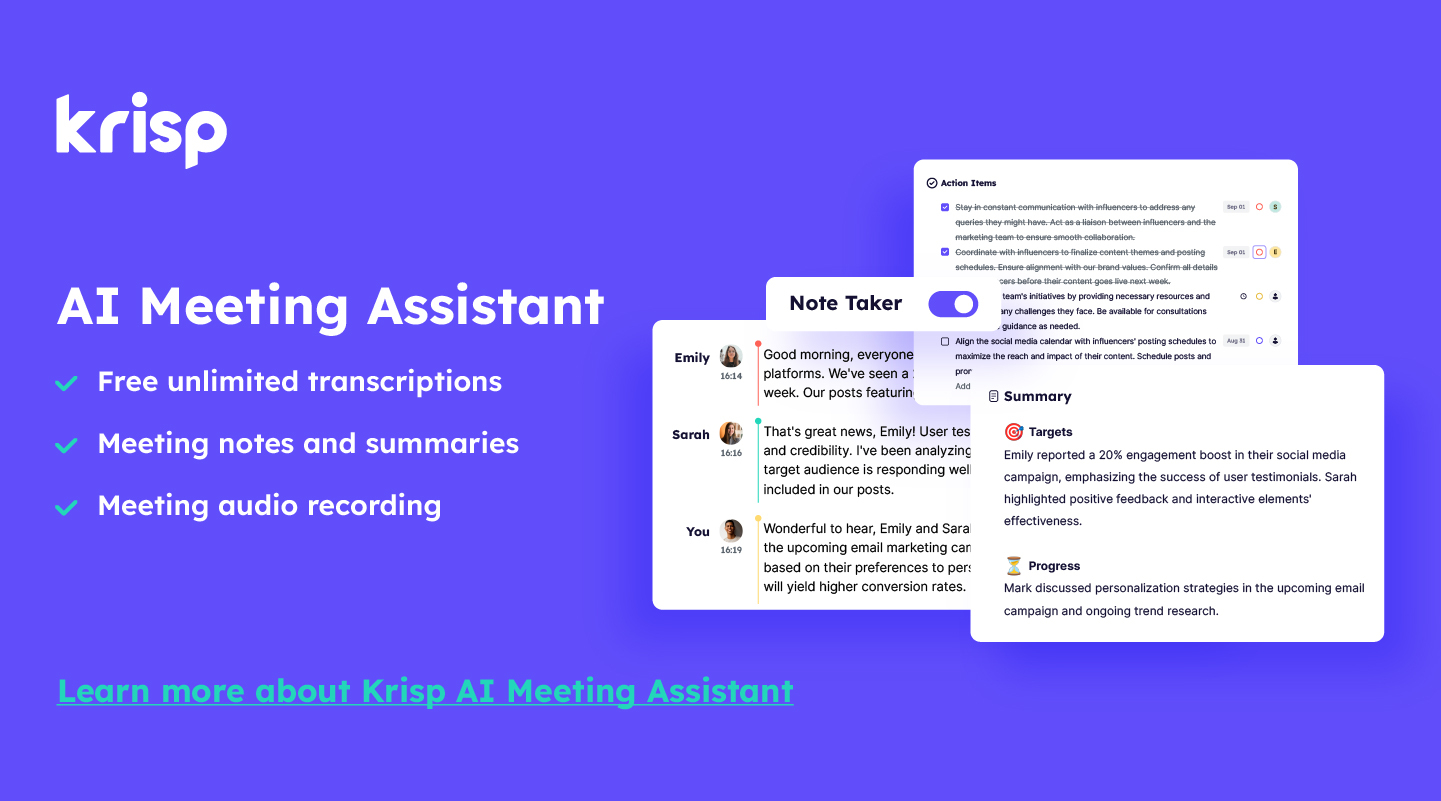Granola stands out with a unique and privacy-focused approach. Its core USP is bot-free, device-audio transcription. Unlike other tools that join your calls as a separate participant to record audio and video, Granola simply uses the audio from your own computer—the same sound you hear through your headphones or speakers. It then transcribes this audio and generates AI notes, with a key privacy guarantee: it never makes audio or video recordings.
The market’s confidence in Granola is undeniable. Following a $20 million Series A in late 2024, the company secured a massive $43 million in May 2025, signalling strong belief in its “bot-free” vision. But does the product live up to the financial hype?
This architecture makes Granola excellent for lightweight, solo note-taking where simplicity and privacy are paramount. However, this same design introduces trade-offs for teams, particularly in areas like multi-user collaboration, sophisticated organization, and synchronized playback, which are staples of bot-based alternatives.
In this review, we’ll put Granola AI to the test in real-world workflows, clarify its privacy stance and pricing, and see exactly where it shines—and where it falls short—before comparing it with the seven best Granola AI review alternatives for every use case and team size.
Granola AI Verdict at a Glance
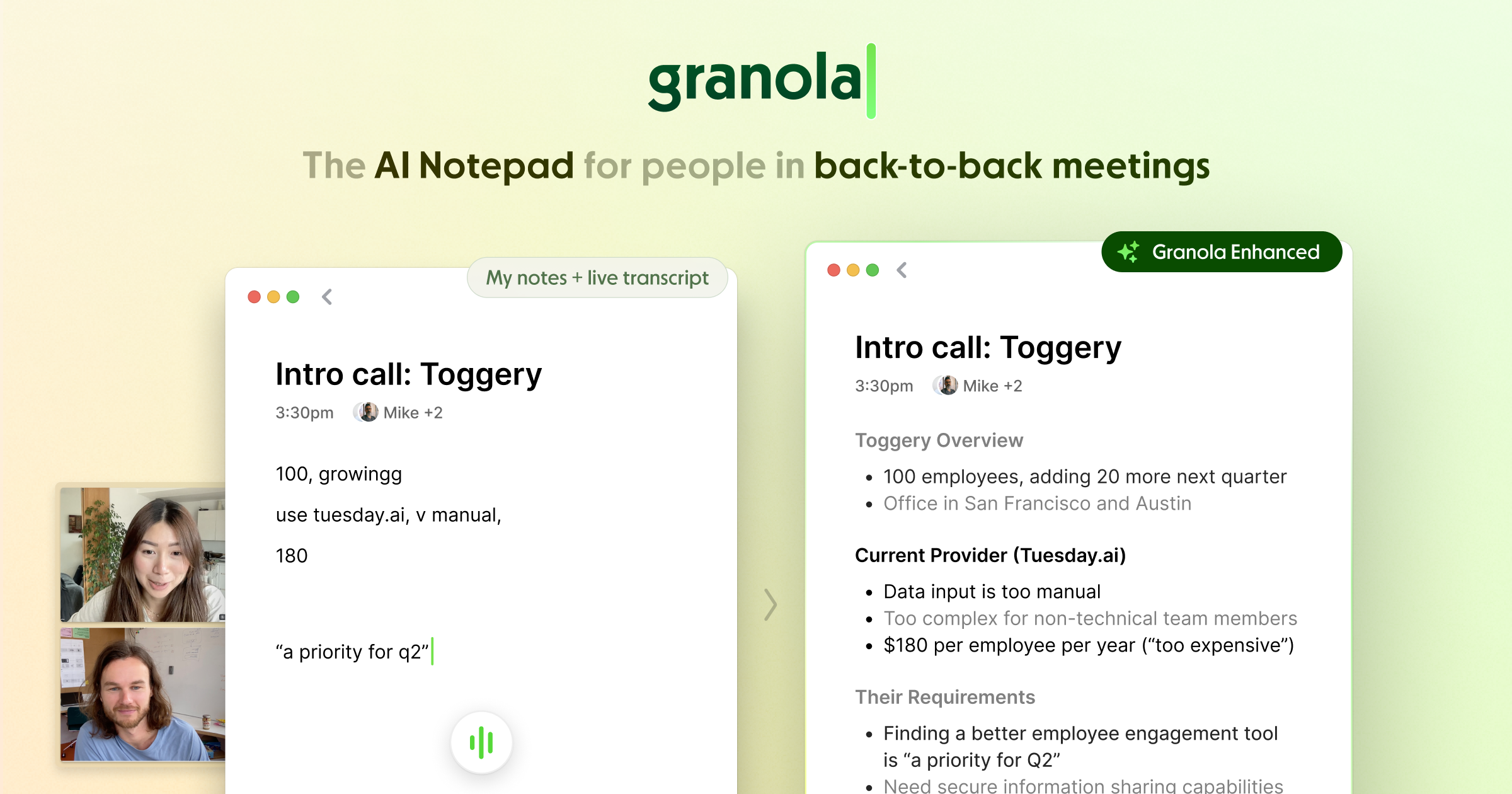
Granola AI carves out a specific niche by prioritizing privacy and simplicity through its unique, bot-free architecture. It excels at providing fast, live transcription and AI notes directly from your device’s audio, eliminating the meeting clutter of a virtual participant. However, this design inherently limits functionality that teams often rely on, such as recording playback and deep workflow integrations, which some Granola AI review alternatives exceed.
Key Strengths and Limitations of Granola AI
Pros:
- No bot joins your calls, creating a distraction-free meeting environment.
- Works with any desktop application that outputs audio, from Zoom to webinars.
- Delivers reliable, real-time transcription for clear audio sources.
- Useful templates and a quick “Ask Granola” feature for instant summaries.
- Granola (Business) offers native integrations with Zapier, Slack, Notion, HubSpot, Attio, and Affinity
Cons:
- No Recording or Playback, which lacks audio/video recording, making it impossible to verify context or review spoken nuance.
- Organization tools are basic, hindering multi-user collaboration and content governance.
- Free Plan Limits: Basic plan includes 14 days of meeting history
- Data for Training: Granola trains on anonymized data by default, and any user can opt out in Settings. Enterprise workspaces have training off by default and org-wide controls
Who Should (and Shouldn’t) Consider Granola
| Best For | Not Ideal For |
| Individual users like freelancers, consultants, and solo note-takers, who prioritize a fast, frictionless, and private way to capture live transcription and notes without a bot. | Teams in sales, customer success, or compliance roles needing call recordings, analytics, and CRM integrations often look for Granola AI review alternatives. |
Onboarding & Setup: Desktop App and Google Workspace Requirement
Getting started with Granola AI is straightforward but comes with two specific technical requirements that are crucial to understand before signing up. Unlike many web-based competitors, Granola requires a desktop application and, for the foreseeable future, a Google Workspace account. This combination provides both the foundation for its device-audio processing and a potential blocker for users outside the Google ecosystem.
The First-Run Experience and Interface
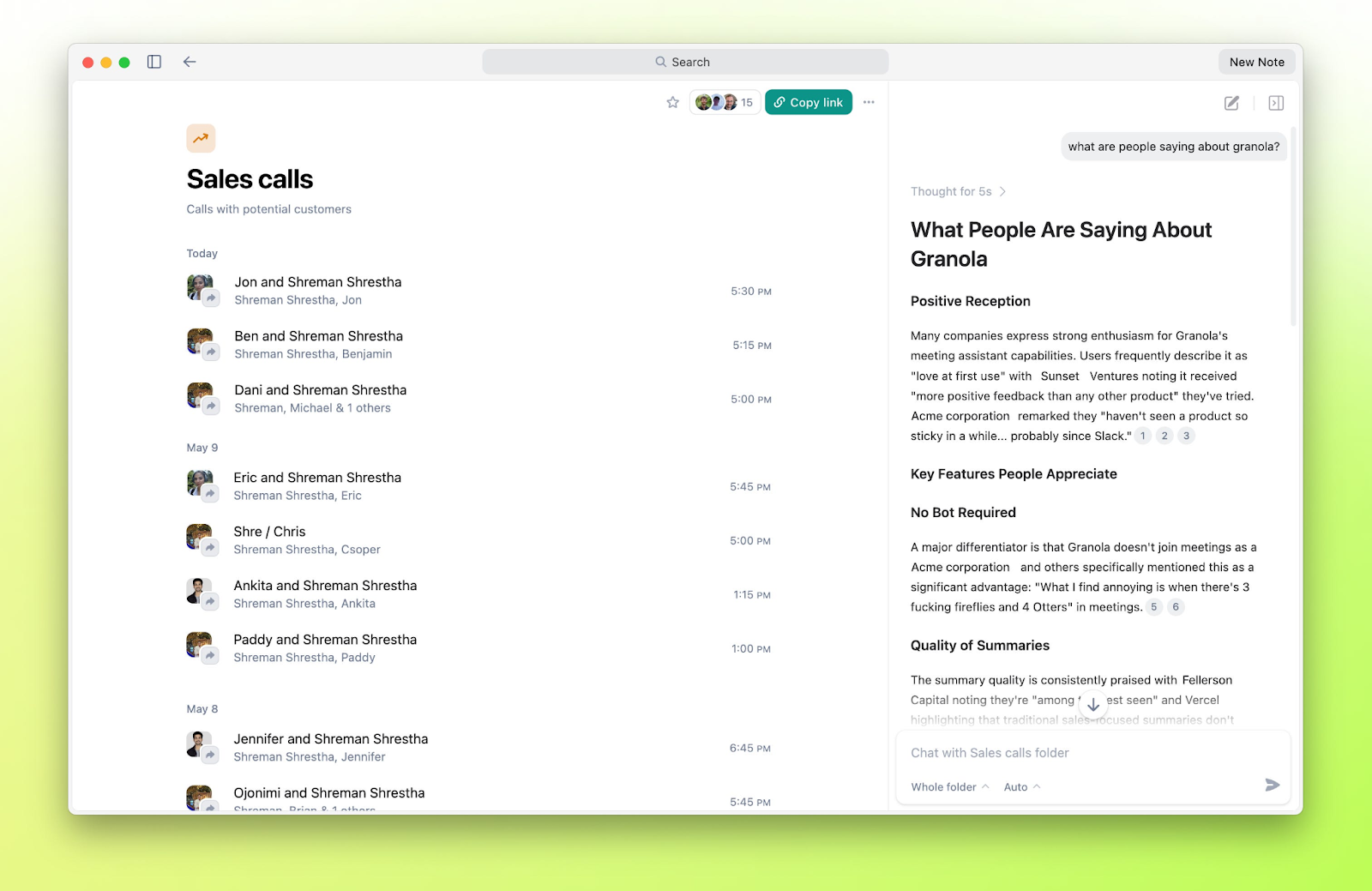
The initial setup involves downloading the desktop app, a step that some users report as a minor point of confusion if they were expecting a purely browser-based tool. Once installed, you’ll log in with your Google Workspace credentials. Historically, this has been a strict requirement, so users with personal Gmail accounts should check for any updated waitlist or policy changes, as this remains a significant gatekeeper.
Upon launching, the interface is clean and minimalist. The core functionality is front and center: you can start a “New Session” to begin transcribing any audio on your computer.
The live transcript appears in a dedicated panel within the app, and AI-generated notes are conveniently housed in a collapsible sidebar. The experience feels immediate and purpose-built for the task, with clear access to your ongoing and past transcription sessions from the main dashboard.
Live Transcription Accuracy & Speaker Identification
Granola AI’s core promise is reliable, real-time transcription, and for the most part, it delivers on this front. In testing, the text-to-speech accuracy for clear audio sources is generally strong and competitive with other lightweight tools.
However, its performance in more complex scenarios reveals the practical limitations of its bot-free architecture, particularly when it comes to speaker identification, which some Granola AI review alternatives provide.
Testing Multi-Language Transcription
A notable feature is its ability to handle multi-language calls. The system can auto-detect languages mid-conversation, which is a significant advantage for international teams or use cases like language learning classes.
It performs well with major languages like Spanish or French, but struggles with heavy accents or rapid code-switching—areas where specialized transcription tools or advanced Granola AI review alternatives tend to do better. So, It’s a capable multi-tool, but not a master of any one language.
The Critical Impact of No Audio/Video Playback
This is Granola’s most significant trade-off. The absence of a recording means there is no way to verify the transcript against the original audio. If the speaker identification is inconsistent in a multi-person call—which it often is—you cannot re-listen to clarify who said what. Minor transcription errors become permanent and unverifiable. This fundamentally impacts trust and makes the tool unsuitable for quality assurance on critical calls, such as legal discussions, investor meetings, or sensitive client negotiations, where every word and its context matter. For these use cases, the inability to playback is a deal-breaker. This limitation alone makes some teams seek Granola AI review alternatives that include playback features for full verification.
AI Notes, Templates & “Ask Granola” in Action
Beyond raw transcription, Granola AI aims to add immediate value through its AI note-taking features. The environment is reminiscent of Notion, offering a clean, editable workspace for your meeting notes. This is supplemented by a library of templates for common meeting types (e.g., project kick-offs, 1:1s) and the ability to create custom templates, which helps standardize note-taking across recurring meetings.
The standout feature for many is “Ask Granola,” a chatbot-like interface that lets you query the transcript in real-time. It excels at providing quick, short answers to factual questions like “What are the action items?” or “Find the discussion about the Q4 budget.” It’s designed for speed and extraction, not for complex, multi-step reasoning. However, Granola AI review alternatives with advanced AI assistants may offer deeper reasoning, memory retention, or integration with external tools.
Limitations of the Q&A Feature
The primary limitation of “Ask Granola” is its lack of persistent context. Your Q&A history does not carry over between sessions, meaning you can’t build a complex understanding across multiple meetings. It’s a powerful tool for interrogating a single call, but it doesn’t learn or retain knowledge from your past interactions, limiting its utility for long-term project tracking. Many Granola AI review alternatives now focus on building memory across meetings, making them better suited for teams that need continuity and cumulative project insights.
Custom Vocabulary for Internal Jargon
For teams with specific terminology, the custom vocabulary feature is a welcome addition. You can upload a list of internal jargon, product names, or technical terms to significantly improve transcription accuracy for those words. However, a key caveat is that this feature is disabled when using multi-language mode. You must choose between accurately transcribing specialized English terms or handling multiple languages, as you cannot effectively do both at once. Teams needing both jargon accuracy and multilingual support often look for Granola AI review alternatives that balance both seamlessly.
Organization, UI & Day-to-Day Use
Granola’s user interface excels in simplicity for individual users but reveals its limitations when used in a team environment. The day-to-day experience is streamlined for solo note-taking, with a clean, focused design that minimizes friction during live transcription. However, Granola AI review alternatives frequently offer tagging, advanced search, and role-based permissions for improved collaboration and governance.
Private vs. Shared Folders for Teams
The platform offers a basic folder system to organize transcripts, with the ability to create both private and shared folders. While this enables fundamental collaboration, it lacks the sophistication teams often need. There are no advanced sorting options, tagging systems, or role-based permissions. This minimal approach works for ad-hoc sharing but feels thin for teams requiring structured knowledge management, robust search across shared assets, or governance over sensitive meeting content. Teams needing structured collaboration often prefer Granola AI review alternatives that feature role-based access, advanced sorting, and centralized search functions across all transcripts.
Calendar Integration and UX Quirks
A genuinely helpful feature is the calendar integration, which automatically detects scheduled Google Meet calls and prompts you to start a session, ensuring you never miss a transcription. This auto-kickoff is seamless and reliable. On the flip side, some UX quirks emerge in daily use. A notable one is the inability to quickly jump to the top of a long transcript; you must manually scroll back up, which can be a minor but persistent annoyance when reviewing lengthy meetings. Overall, the experience is polished for an individual’s workflow but can feel underdeveloped for multi-user governance and scalability. Many Granola AI review alternatives refine this user experience with smoother navigation, better layout controls, and enhanced automation.
Granola Privacy, Data Use & Legal Considerations
Granola’s core architecture—transcribing device audio with no bot and no separate A/V recording—creates a uniquely seamless user experience from a privacy perspective. However, this technical approach does not eliminate the user’s legal and ethical obligations. The very invisibility of the tool means the responsibility for transparency falls entirely on you.
How Device-Only Audio Affects Consent Rules?
While Granola doesn’t create a traditional recording, it is still capturing and processing the conversation. In the eyes of the law in many regions, this constitutes transcription or recording, triggering consent requirements. In two-party or all-party consent jurisdictions (like California or parts of the EU), you are legally obligated to inform all participants and obtain their consent before starting a Granola session. The lack of a bot makes the process less obtrusive but does not change the legal baseline.
A critical, and often overlooked, aspect of Granola’s data use is its policy on model training. By default, your transcription data is used to train and improve Granola’s AI models. The company mentions anonymization, but the specifics of this process are not publicly detailed. The ability to opt out of this data training is a feature reserved exclusively for Enterprise plan subscribers, meaning individual and Business tier users implicitly agree to contribute their data to the model.
Ethical use mandates proactive disclosure. A simple, effective practice is to include a standard notice in your meeting invitations: “For note-taking purposes, I use an AI transcription tool that processes audio locally. Please let me know if you have any concerns.” For highly sensitive discussions—such as legal negotiations, HR conversations, or confidential financial deals—it is advisable to avoid any cloud-processed transcription tool altogether unless you have a signed Enterprise agreement with explicit data control guarantees. In these scenarios, the risk outweighs the convenience.
Granola AI Pricing: Plan Breakdown & Hidden Limits
Granola’s pricing structure appears straightforward with three main tiers, but a closer look reveals important constraints, especially for free users. Understanding these limits is crucial to determining the true value proposition for your use case.
Granola Basic vs. Business vs. Enterprise
| Plan | Price per month | It gives | |
|---|---|---|---|
| Basic | ($0/month) | The free plan offers a compelling taste of Granola’s core features. Its key limitation is a restricted history, capping the number of past sessions you can access. It also lacks advanced admin controls and SSO, though it does include shared folders. Designed for occasional, lightweight use.
|
|
| Business | $15/user/month (monthly) or $12/user/month (annual) | This tier removes the history cap, offering “unlimited notes and history.” It adds team management features like shared folders and is the minimum required for any form of collaboration. | |
| Enterprise | $35/user/month | Aimed at larger organizations, this plan includes advanced security controls (SSO), dedicated support, and, most notably, the ability to opt out of data training for the AI models. |
Understanding the Free Plan’s Constraints
The primary constraint of the Basic plan is the limited session history. While live transcriptions are available, you cannot build a long-term, searchable knowledge base of all your meetings. The exact number of sessions stored is not always explicitly advertised, which may cause confusion. Basic is designed for solo or occasional use. Importantly, while it does include shared folders, deeper admin controls and SSO are only available on Enterprise.
Value Assessment: Is Granola Pricing Competitive?
For a solo user who needs lightweight, bot-free note-taking, the Basic plan offers excellent value. The Business plan, however, faces stiffer competition. While $15/user/month is competitive on paper, teams paying this price for “unlimited notes” must remember they are still not getting meeting recordings, playback, speaker analytics, or robust post-call automations that are standard in similarly priced alternatives like tl;dv or Fireflies. Therefore, Granola’s pricing is competitive only for those who specifically value the bot-free model above all else; for teams seeking a full-featured meeting intelligence platform, it may represent a poorer value despite the lower cost.
Granola AI Review Alternatives: 7 Tools Compared for 2025
Choosing the right Granola AI review alternatives requires careful evaluation of several key metrics that determine a tool’s effectiveness for team collaboration and workflow integration.
Our analysis of the top alternatives focuses on five critical dimensions:
- Recording & Playback: The ability to capture and review meeting context through audio/video recording
- Speaker ID Quality: Accuracy in identifying and distinguishing between multiple speakers
- Granola offers native integrations (Business): Zapier, Slack, Notion, HubSpot, Attio, Affinity
- Admin & Analytics: Team management features and meeting intelligence insights
- Data Controls: Privacy protections and data usage transparency
After thorough testing across these criteria, Krisp emerges as our top recommendation for most teams seeking a balanced upgrade path from Granola. It preserves the simplicity users appreciate while adding the enterprise-grade features that growing organizations require.
Krisp: Best All-Around Granola AI Alternative
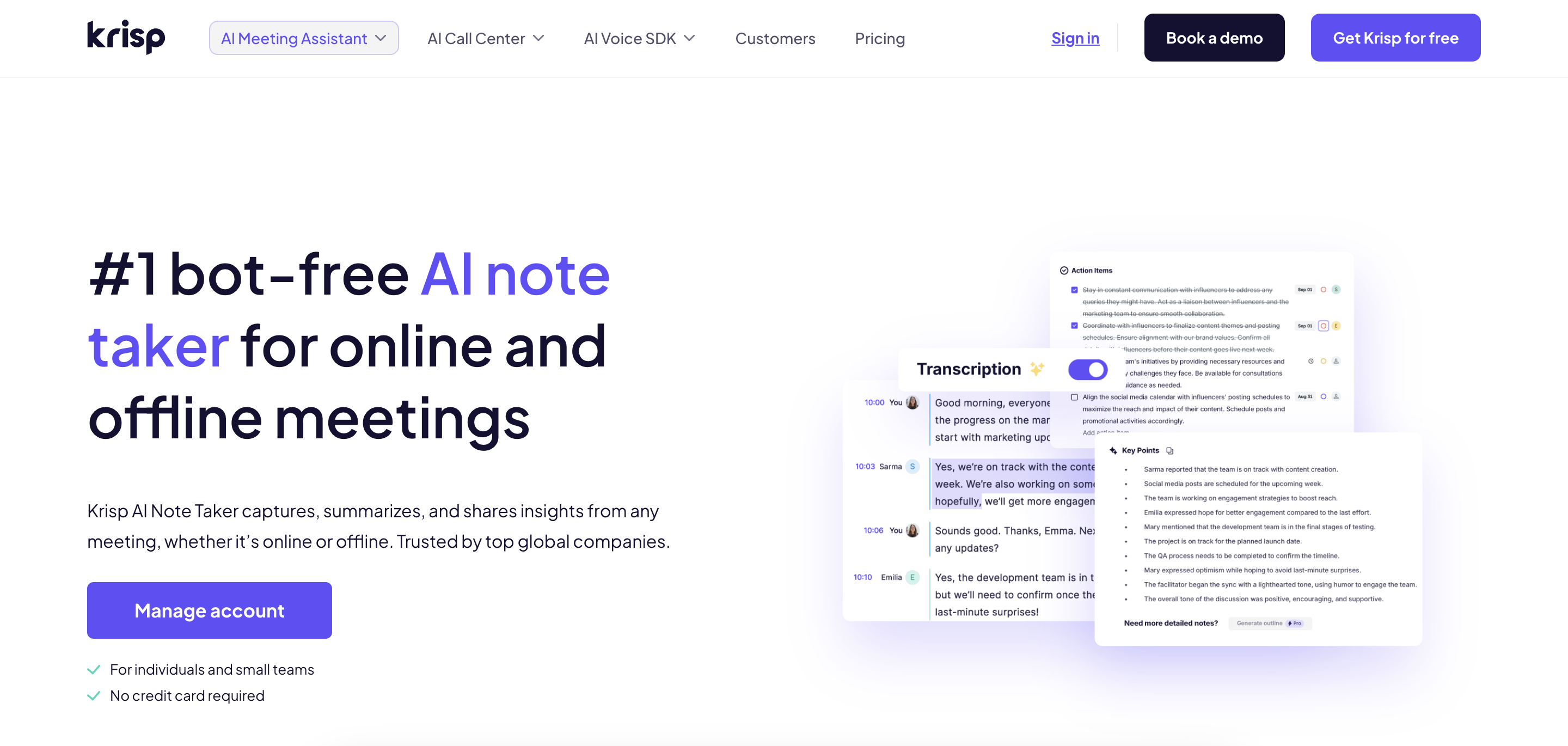
Krisp AI meeting assistant emerges as our top recommendation for teams seeking a balanced alternative to Granola. Alongside its AI-powered noise cancellation and accent neutralization, it delivers the capabilities Granola lacks, including full meeting recording with searchable transcripts, reliable speaker identification in group settings, and automated workflow integration with tools like Slack, Google Docs, and Salesforce.
Krisp Key Features
- Complete recording with accurate, real-time meeting transcription
- AI-powered noise cancellation and accent conversion for clearer communication
- Reliable speaker identification for clear voice attribution
- Automated workflow integration with Docs, Slack, and CRMs
- AI-powered note-taking and action item tracking
- Team administration controls and usage analytics
- Enterprise-grade data governance and privacy options
Pros
✅ Full meeting capture enables quote verification and rep coaching
✅ Automated workflows eliminate manual note distribution
✅ Speaker identification makes team meetings easy to follow
✅ Team management features support scaling organizations
✅ Clear data controls meet enterprise compliance requirements
✅ Strong ROI through time savings and workflow automation
Where Krisp Isn’t Ideal
❌ Free plan caps may not fit enterprise teams
G2 Rating for 2025 October: 4.7/5 (Krisp reviews on G2)
Tl;dv: Best for Customer-Facing Teams

Tl;dv Key features
- Auto notes & summaries across Zoom, Meet, and Teams
- Recurring, multi-meeting reports and cross-meeting analytics
- Sales coaching playbooks (BANT/MEDDIC), performance dashboards, objection handling tips
- 6,000+ integrations with CRMs, PM tools, and collaboration platforms
Tl;dv Pros
✅Excellent “across-meetings” intelligence for spotting patterns and trends
✅Features that help with sales (playbooks, coaching, dashboards)
✅A very large library of integrations
Tl;dv Cons
❌Advanced features like unlimited multi-meeting reports and full integrations are only on paid tiers
⭐ G2 Rating for 2025 October: 4.7/5 (Tl;dv reviews on G2)
Otter.ai: Best for Real-Time Collaboration
Otter AI Key Features
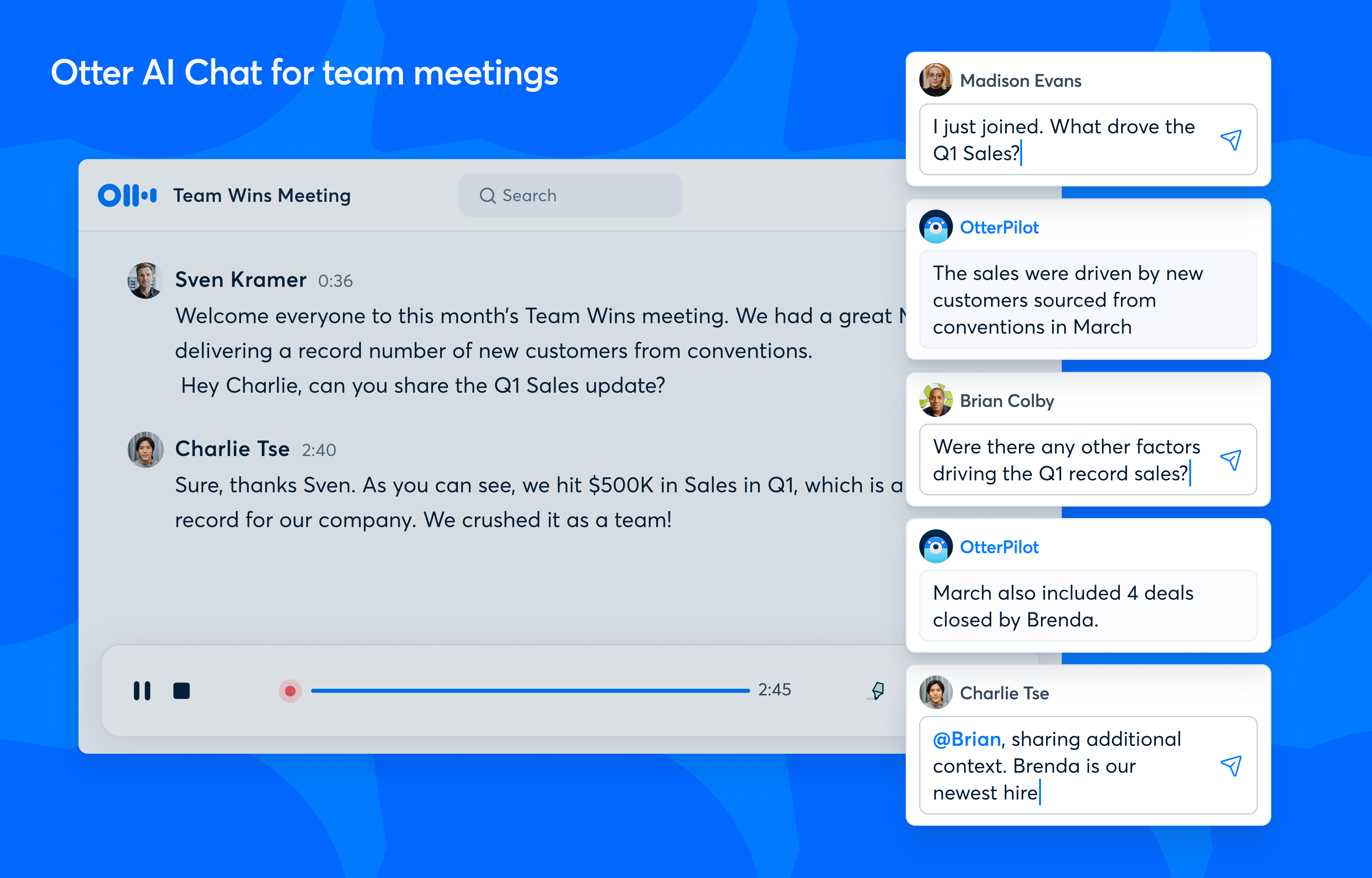
- Real-time transcription in Zoom, Teams, Meet
- AI Chat + OtterPilot for summaries and action items
- Free plan: unlimited meetings, 300 minutes/month, 3 imports
- Cross-platform: web, iOS/Android, Chrome extension
- Paid plans expand to 1,200–6,000 minutes & CRM/SSO
Pros
✅ Real-time transcription and summaries
✅ AI Chat answers questions instantly
✅ Multi-device support
✅ Free tier good for light use
✅ Supports English, French, Spanish
Cons
❌OtterPilot may seem intrusive in sensitive meetings, as its presence can disrupt conversation flow
⭐ G2 Rating for 2025 October: 4.4/5 (Otter reviews on G2)
Fireflies.ai: Best for Automated Workflows
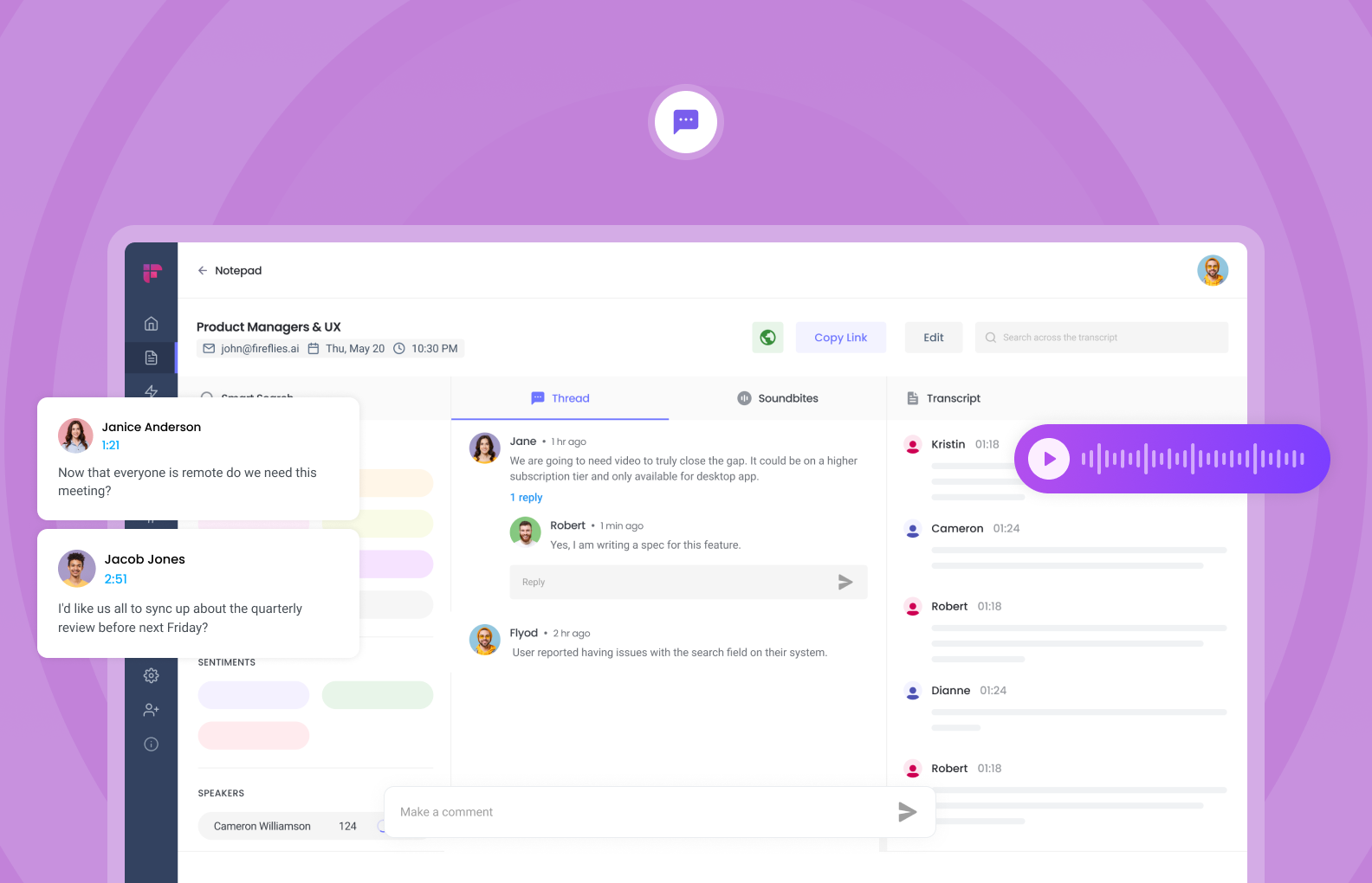
Fireflies AI Key Features
- Real-time transcription for Zoom, Google Meet, Teams, Webex
- AI summaries, action items, topic detection
- Integrations: Slack, Notion, HubSpot, Salesforce, Asana, CRMs
- “AskFred” AI assistant + smart search & analytics
- Mobile apps, Chrome extension, API access
- GDPR, SOC 2 Type II, HIPAA (higher tiers)
Pros
✅ Collaboration features: highlight, comment, share
✅ Broad integrations keep workflows seamless
✅ Free plan: unlimited transcription + 800 minutes storage
✅ Searchable archives for quick decisions
✅ Analytics (sentiment, speaker talk time) add insights
Cons
❌ Bot can join late or feel intrusive
⭐ G2 Rating for 2025 October: 4.8/5 (Fireflies reviews on G2)
Gong: Best for Enterprise Sales Intelligence

Gong Key Features
- Automated coaching and performance management
- Deep CRM integrations (Salesforce, HubSpot)
- Market intelligence and competitive insights
- Enterprise-grade security and compliance
Pros
✅ Accurate conversation intelligence drives revenue growth
✅ Automated coaching improves team performance
✅ Deep CRM integrations provide seamless workflow
✅ Enterprise-grade security meets strict compliance needs
✅ Market intelligence reveals competitive trends
Cons
❌ Overkill for non-revenue teams and individual users
❌ Complex implementation requires dedicated setup
⭐ G2 Rating for 2025 October: 4.7/5 (Gong reviews on G2)
Loom: Best for Async Communication
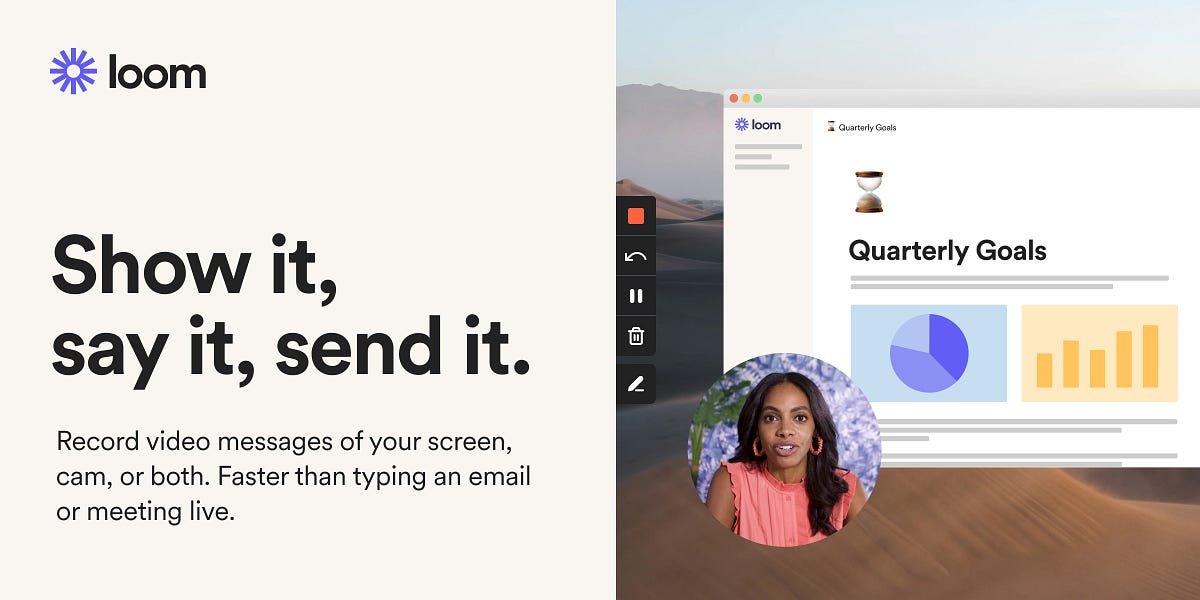
Loom Key Features
- Async video messaging for quick updates and feedback
- Screen and camera recording
- Interactive elements (reactions, comments)
- Video editing and clip creation
- Centralized video library and sharing
- Basic integrations with Slack, Notion, and Google Docs
Pros
✅ Saves meeting time with async communication
✅ Easy to create and share professional videos
✅ Engagement analytics show viewer data
✅ Simple, intuitive interface
✅ Free plan available with core features
Cons
❌ Not designed for live meeting transcription
❌ Limited transcription and AI note-taking features
❌ Basic integrations compared to dedicated meeting tools
⭐ G2 Rating for 2025 October: 4.7/5 (Loom reviews on G2)
Why Consider a Granola AI Review Alternative?
You should evaluate other options if you require:
- Recording & Playback: The ability to listen back to verify context, coach team members, or capture nuanced discussions
- Advanced Team Features: Robust permission controls, shared workspaces, and collaboration tools
- Workflow Automation: Automatic syncing of notes and action items to your CRM, project management, or documentation tools
- Enterprise Data Controls: Granola trains on anonymized data by default, and any user can opt out in Settings. Enterprise workspaces have training off by default and org-wide controls.
- Reliable Speaker Identification: Consistent speaker diarization in meetings with multiple participants
Granola vs. The Market
| Tool | Recording & Playback | Speaker ID Quality | Automations & CRM | Admin & Analytics | Data Controls | Best For |
|---|---|---|---|---|---|---|
| Krisp | ✅ Full meeting recording + transcripts | ✅ Good real-time diarization | ✅ Slack, Docs, HubSpot, Salesforce, Zapier | ✅ Team controls, usage insights | ✅ Local/server modes, enterprise privacy | Teams needing reliable capture + automated workflows |
| tl;dv | ✅ Cross-platform recording & transcription | ✅ Strong for group calls | ✅ Deep integrations (Slack, Notion, HubSpot) | ✅ Shared libraries, basic analytics | ⚠️ Varies by plan | Teams wanting easy recording + integrations |
| Otter.ai | ⚠️ Focused on live transcription | ✅ Good speaker separation | ⚠️ Basic integrations, less CRM depth | ⚠️ Light team tools | ⚠️ Limited enterprise control | Sales/support teams needing archives & CRM sync |
| Fireflies.ai | ✅ Full recording & transcription | ✅ Good diarization | ✅ CRM (Salesforce, HubSpot), Slack, Zapier | ✅ Team workspaces, analytics | ⚠️ Some model training on lower tiers | Sales/support teams needing archives & CRM sync |
| Gong | ✅ Advanced recording & transcription | ✅ Accurate diarization | ✅ Deep native CRM + deal insights | ✅ Enterprise analytics & coaching | ✅ Enterprise-grade governance | Revenue intelligence & sales coaching |
| Loom | ✅ Async video recording (not live) | ✅ Good diarization | ⚠️ Basic integrations (Slack, Docs) | ⚠️ Limited admin features | ⚠️ Not transcription-focused | Async communication & training content |
Key Advantages & Disadvantages vs. Granola
| Tool | Key Advantages vs. Granola | Main Disadvantages vs. Granola |
|---|---|---|
| Krisp | • Full meeting recording with playback
• Superior speaker identification • Automated workflow integrations • Team admin controls & analytics |
Free plan caps may not fit enterprise teams |
| tl;dv | • Video recording capability
• Advanced clip-sharing features • Deeper CRM integrations • Better for customer insights |
• Bot joins meetings visibly
• Higher cost for full feature set |
| Otter.ai | • Superior real-time collaboration
• Better mobile experience • Stronger live editing features |
• Limited CRM integration depth
• Less focused on post-meeting automation |
| Fireflies.ai | • Advanced workflow automation
• Deep CRM connections • Comprehensive meeting analytics |
• Can be overwhelming for individual users
• Steeper learning curve |
| Gong | • Enterprise-grade analytics
• Revenue intelligence features • Sales coaching capabilities |
• Significant cost premium
• Overkill for non-sales teams |
| Loom | • Excellent for async communication
• Simple video creation & sharing • Great for training & demos |
• Not designed for live meetings
• Limited transcription features |
Final Thoughts: Is Granola AI Right For You?
Granola AI successfully delivers on its core promise: frictionless, bot-free transcription that respects meeting privacy. For individual users like freelancers, consultants, and solo note-takers, it provides an excellent, streamlined solution for capturing personal meeting notes without the intrusion of a virtual participant.
However, teams will quickly encounter its limitations. The lack of audio/video playback makes verification and coaching impossible, while thin organizational tools and limited integrations create workflow bottlenecks. The default data training policy also raises privacy considerations for sensitive business discussions.
If you’re exploring broader options for AI-assisted productivity, check out our guide to the best AI note-taking apps — it compares top-rated tools designed for teams that need full meeting recording, playback, and collaboration features.
Choose Granola if: You are an individual who values maximum simplicity and privacy above all else, and can accept the trade-offs of no playback and basic features.
Choose an alternative now if: You work in a team setting, need recordings for compliance or coaching, require automated workflows with other tools, or handle sensitive information. In these cases, Krisp provides the most balanced upgrade, while Fireflies.ai excels at automation, and tl;dv is ideal for customer-facing teams.


